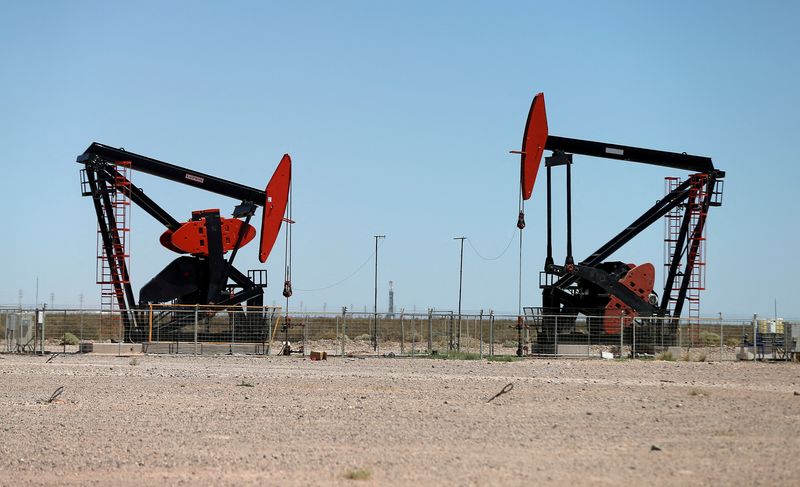Oil drops more than $1 as China’s COVID protests fuel demand worries
2022.11.27 20:34
[ad_1]

© Reuters. FILE PHOTO: Oil pump jacks are seen at the Vaca Muerta shale oil and gas deposit in the Patagonian province of Neuquen, Argentina, January 21, 2019. REUTERS/Agustin Marcarian/File Photo/File Photo
By Yuka Obayashi
TOKYO (Reuters) – Oil futures fell more than $1 early on Monday as protests in top importer China over strict COVID-19 curbs fuelled demand worries, while investors remained cautious ahead of an agreement on a Western price cap on Russian oil and an OPEC+ meeting.
dropped $1.01, or 1.2%, to trade at $82.62 a barrel at 0110 GMT. U.S. West Texas Intermediate (WTI) crude slid $1.09, or 1.4%, to $75.19.
Both benchmarks, which hit 10-month lows last week, have posted three consecutive weekly declines. Brent ended the latest week down 4.6%, while WTI fell 4.7%.
“On top of growing concerns about weaker fuel demand in China due to a surge in COVID-19 cases, political uncertainty, caused by rare protests over the government’s stringent COVID restrictions in Shanghai, prompted selling,” said Hiroyuki Kikukawa, general manager of research at Nissan (OTC:) Securities.
WTI’s trading range is expected to fall to $70-$75, he said, adding the market could stay volatile depending on the outcome of the OPEC+ meeting and the price cap on Russian oil.
China, the world’s top oil importer, has stuck with President Xi Jinping’s zero-COVID policy even as much of the world has lifted most restrictions.
Hundreds of demonstrators and police clashed in Shanghai on Sunday night as protests over China’s strict COVID restrictions flared for a third day and spread to several cities in the wake of a deadly fire in the country’s far west.
The wave of civil disobedience is unprecedented in mainland China since Xi assumed power a decade ago, as frustration mounts over his zero-COVID policy nearly three years into the pandemic.
Meanwhile, Group of Seven(G7) and European Union diplomats have been discussing a price cap on Russian oil of between $65 and $70 a barrel, with the aim of limiting revenue to fund Moscow’s military offensive in Ukraine without disrupting global oil markets.
But a meeting of EU government representatives, scheduled for Nov. 25 evening to discuss the issue, was cancelled, EU diplomats said. The price cap is due to come into effect on Dec. 5 when an EU ban on Russian crude kicks off.
Investors are also focusing on the next meeting of the Organization of the Petroleum Exporting Countries and allies, known as OPEC+, on Dec. 4.
In October, OPEC+ agreed to reduce its output target by 2 million barrels per day through 2023.
[ad_2]
Source link








